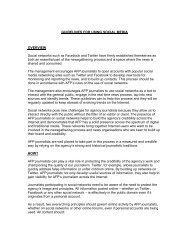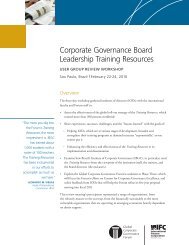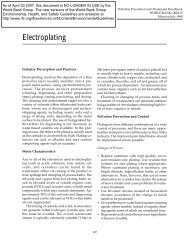SME Finance Policy Guide
SME Finance Policy Guide
SME Finance Policy Guide
Create successful ePaper yourself
Turn your PDF publications into a flip-book with our unique Google optimized e-Paper software.
G-20 <strong>SME</strong> FINANCE POLICY GUIDE<br />
37<br />
Without a payment system that is sufficiently effective,<br />
efficient, stable, and competitively neutral to elicit<br />
confidence on the part of the banks that use it, modern<br />
modes of carrying out financial transactions would be<br />
impossible, or at least very costly.<br />
Most <strong>SME</strong> businesses conduct business using cash.<br />
However, cash is subject to loss, theft, and destruction<br />
in a multitude of ways. Payment, clearance, and settlement<br />
systems that are effective, efficient, and stable<br />
encourage entrepreneurs to move into the formal<br />
economy and facilitate their relations with banks.<br />
The infrastructure to support corporate payment and<br />
retail payments can also play a role in scaling up <strong>SME</strong><br />
access to financial services and reduce the costs of<br />
doing business. Payment system service providers have<br />
developed a number of products to facilitate “corporate<br />
payments” in the entire value chain of doing business.<br />
<strong>SME</strong>s rely on the retail payment infrastructure for<br />
their customers to discharge their obligations as well.<br />
Both segments are relatively less developed for <strong>SME</strong>s<br />
than for larger corporations.<br />
Standards, <strong>Guide</strong>lines, and Good Practices<br />
A wide range of cost-effective payment instruments is<br />
essential for supporting economic development and<br />
customers’ needs in a market economy. The development<br />
of a country’s commercial, industrial, and<br />
financial sectors generally increases demand for<br />
greater diversity and use of non-cash retail payment<br />
instrument and services. Migrating cash-based payments<br />
to electronic payment mechanisms 40 like electronic<br />
funds transfers, card payments, and mobile<br />
payments would lead to important savings while<br />
expanding reach and increasing inclusion. Payment<br />
system reform initiatives would need to focus, therefore,<br />
on extending the availability and choice of efficient<br />
and secure non-cash payment instruments and<br />
services to consumer and businesses.<br />
It is important that public authorities develop a<br />
coherent and holistic reform strategy. The World<br />
Bank is in the process of issuing <strong>Guide</strong>lines for<br />
Developing a Comprehensive Retail Payments<br />
Strategy. Such guidelines are based on clear public<br />
policy objectives that need to guide the policies<br />
and actions of national authorities in countries<br />
with under-developed retail payment systems. Key<br />
public policy objectives are: (i) safety and efficiency;<br />
(ii) affordability and ease of access to payment<br />
instruments and services; (iii) availability of<br />
an efficient infrastructure to process electronic<br />
payment instruments; and, (iv) availability of a<br />
socially optimal mix of payment instruments.<br />
These public policy goals should guide the actions<br />
of the public authorities, specifically the central<br />
bank, to positively impact the drivers of retail payment<br />
system development.<br />
To implement such goals, regulatory authorities should<br />
consider using the following guidelines in designing<br />
their retail payments development agenda:<br />
<strong>Guide</strong>line I: The market for retail payments should be<br />
transparent, have adequate protection of payers and<br />
payees interests, and be cost-effective.<br />
<strong>Guide</strong>line II: Retail payments require certain underlying<br />
financial, communications, and other types of<br />
infrastructure; these infrastructures should be put<br />
in place to increase the efficiency of retail payments.<br />
These infrastructures include interbank<br />
electronic funds transfer systems, inter-bank card<br />
payment platforms, credit bureaus, data-sharing<br />
platforms, interbank real-time gross settlement systems,<br />
reliable communications infrastructure, and<br />
a national identification system for individuals.<br />
<strong>Guide</strong>line III: Retail payments should be supported<br />
by a sound, predictable, non-discriminatory, and<br />
proportionate legal and regulatory framework.<br />
40 The adoption of the electronic payment mechanisms ranges from less than 1 transaction per capita in Africa, to more than 150 in<br />
high-income countries.














![Print a two-page fact sheet on this project [PDF] - IFC](https://img.yumpu.com/43449799/1/190x245/print-a-two-page-fact-sheet-on-this-project-pdf-ifc.jpg?quality=85)


